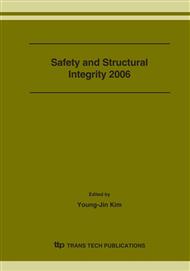[9]
it takes only about 17 hours to penetrate the weld leg under the vibration condition of CVCS. It means that the socket weld is very susceptible to vibration if there is 'no gap' in the socket weld. As analyzed in section 3.3.1 in this paper with the result from Fig. 6, it takes about 8.25 days to penetrate the weld leg if there is gap larger than 1/16 inch. Fig. 7 shows the gap (g) effect under the thermal transient loading for the values of g=0 and g=1.5875 mm (1/16 inch). The gap of 1.588 mm (1/16 inch) is sufficient to protect the contact because there is only 0.069 mm thermal expansion of the pipe inside the fitting under the thermal transient of � T= 263 o C. The difference between the two cases represents the gap effect excluding the thermal transient effect. The stress intensity factor at the normal operating temperature (288o C) is estimated as 1,182.7 MPa� (mm). If the transient loading from P=0 and T=25 o C to P=15.51 MPa and T=288 o C is considered in the analysis, the stress intensity factor is estimated as 1,811.6 MPa� (mm). Under this transient loading condition, the fatigue crack growth rate (da/dN) is calculated as 2.18E-03 mm/cycle. It means that it takes about 4,370 cycles to penetrate the weld leg (9.525 mm). If such transient load is applied to the socket weld ever day, the socket weld will be failed within 7.3 years. The results show that 'no gap' is very risky to the socket weld integrity for the specific systems having the vibration condition to exceed the requirement in the ASME Code OM and/or the transient loading condition from P=0 and T=25 oC to P=15.51 MPa and T=288 o C. To such systems, RT to examine the gap during construction stage is strongly recommended. Conclution The effects of the requirements in ASME Code Sec. III on the socket weld integrity were evaluated using 3 dimensional finite element method. Three types of loading conditions such as the deflection due to vibration, the pressure transient load from P=0 to 15.51 MPa, and the thermal transient load from T=25 o C to 288 o C were considered. The results are as follows; (1) The socket weld is susceptible to the vibration where the vibration levels exceed the requirement in the ASME Operation and Maintenance (OM) Code. (2) The effect of pressure or temperature transient load on socket weld in CVCS and PSS is not significant owing to the low frequency of transient during plant operation. (3) 'No gap' is very risky to the socket weld integrity for the systems having the vibration condition to exceed the requirement specified in the ASME OM Code and/or the transient loading condition from P=0 and T=25 o C to P=15.51 MPa and T=288 o C. Rererence
Google Scholar
[1]
ASME, ASME Boiler and Pressure Vessel Code Sec. III NB (2001).
Google Scholar
[2]
ASME, ASME Boiler and Pressure Vessel Code Sec. XI (2001).
Google Scholar
[3]
EPRI, Reactor Piping Failures at US Commercial LWRs : 1961-1997, EPRI TR-110102, (1998).
Google Scholar
[4]
OECD/NEA, OECD Piping Failure Data Exchange (OPDE) Project, (2002).
Google Scholar
[5]
USNRC, Rate of Initiating Events at U.S. Nuclear Power Plants : 1987-1995 NUREG/CR-5250, (1998).
Google Scholar
[6]
USNRC, Pipe Cracking Experience in LWR, NUREG-0679, (1980).
Google Scholar
[7]
USNRC, Investigation and Evaluation of Cracking Incidents in Piping in PWR, NUREG-0691, (1980).
Google Scholar
[8]
USNRC, Erosion/Corrosion-Induced Pipe Wall Thinning in US NPPs, NUREG-1344, (1989)
Google Scholar
[9]
ASME, ASME Code OM, Requirements for Pre-operational and Initial Start-Up Vibration Testing of Nuclear Power Plants, ASME Boiler and Pressure Vessel Code Operation and Maintenance(OM) Part 3, (2001). L2 L1 t1 t2 ri g i WL WL d Lp 2WL Path 1 $ ' Socket Weld & � % Fitting Pipe Fig.1 Geometry of socket weld with pipe and Fitting Fig. 2 3 Dimensional FEM modelling for socket weld � � � � � � � � � � � 'HI�HFW�RQ��PP �����UHI 23(1�0RGH &�26(�0RGH � � � � � � � � �� �� �� 3UHVVXUH��03D �����UHI Fig.3 Deflection effect on stress intensity factor(K) Fig.4 Pressure effect on stress intensity factor(K) � � � � � � � ��� ��� ��� 7HPSHUDWXUH ��7��&� �����UHI ������������� � � � � � � � � � � � �DS��PP� �����UHI 23(1�0RGH &�26(�0RGH Fig.5 Temperature effect on stress intensity factor(K) Fig.6 Gap effect on K under deflection load �������������� � � � � � � � ��� ��� ��� 7HPSHUDWXUH ��7��&� �����UHI �DS� ���� �PP �DS� ��PP Fig.7 Gap effect on K as a function of temperature
Google Scholar


